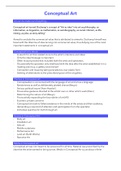Conceptual Art
Art can be made out of anything...
Conceptual art turned Duchamp’s concept of “Art as idea” into art as philosophy, as
information, as linguistics, as mathematics, as autobiography, as social criticism, as life-
risking, as joke, as story-telling”
Aimed to exclude the commercial value that is attributed to artworks. Duchamp himself was
faced with the dilemma of idea turning into commercial value, thus defying one of the most
important statements in conceptual art.
Conceptual art is about:
- A search for art that related more to the artist’s intentions and ideas
- Only the idea/message is important
- Often mutual process that included both the artist and spectators.
- Occasionally the spectator only interfaced with the idea after the artist established it in a
meeting point e.g. a gallery environment
- Conception and meaning taking precedence over plastic form
- Seeking of alternatives to the prescribed space of the art gallery
Themes in Conceptual art:
- Conceptualism is concerned with the language of art and art as a language
- Randomness as well as deliberately plotted chance (Beuys)
- Serious political issues (‘Hans Haacke’)
- Provocative gestures directed at the artists’ own or other artist’s work (Klein)
- Determining the nature of art (Beuys)
- Provocatively expanding the boundaries of art (All)
- Eccentric private concerns
- Conceptual art took its fullest existence in the minds of the artists and their audience,
demanding a new kind of attention and participation from the spectator.
- Individual searches for truth through art
Genres in Conceptual Art:
- Body art
- Installation art
- Idea art
- Mobile sculptures
- Performance Art
- Land art (Earth Works)
- Narrative Art
Media in Conceptual art:
Conceptual art was not meant to be preserved for all time. Material was prescribed by the
idea that the artist wanted to bring across. Media in Conceptual Art is just about infinite
, The role of the Critic in Conceptual Art
The critic is eliminated in Conceptual art because the artist himself performs the critical
function during the process of presenting his concept. The essence is always the concept,
and not whether a work is well–executed or not. The work of art is an idea, of which the artist
is not only the creator but also the interpreter and judge as well.
Early Conceptual artists that used language/words as concept
Joseph Kosuth included the written word in his displays. “One and Three Chairs”, 1965, comprises of
an actual chair, a full-scale photograph of the same chair, and the printed dictionary definition of a
chair. Kosuth separates art from aesthetics or formalism and all kinds of imitation of the observed
reality. The title is a clue to the understanding of the work. Which is the “One” chair?
“One and Three Chairs”, 1965
Wooden folding chair, photograph of a chair, photographic enlargement of dictionary definition of a
chair. Collection of the Museum of Modern Art in New York.
Installation as concept
Edward Kienholz
Kienholz belonged to the California school of FUNK ART who collected
bizarre remnants of contemporary
life, and created
situations in which figures were placed amongst real objects. His brutal
images of humanity have both attracted and repelled the imaginations of
spectators. South African artist Jane Alexander assembles her works on a very
similar basis e.g. “Stripped, Oh Yes Girl”, -a harsh portrayal of a suspended
female figure. Alexander refrains from explaining her works because she
relies on the conscious and subconscious knowledge of the spectator, to
attach meaning to the work. These installations are on life-size scale,
enhancing the sense of reality, thus facilitating the maximum response from
the spectator. The theme of horror and the sensationalism surrounding it was
also explored in the works of Pop artist Andy Warhol in his disaster-series e.g.
“Orange Disaster” and “Saturday Disaster” of 1965.
In “The Wait” (1965) Kienholz assembled a tableau that portrays the projected hopes of an
individual, placed in stark contrast to the present reality in which that person finds herself. The
figure is reduced to skeletal bones that barely contain any muscle tissue, trapped in elaborate
clothes, still waiting for the realization of her dreams. Kienholz manages to capture the futility of
the wait, not only in the presentation of a skeleton as reference to the passing of time, but also in
the full suitcase; the empty womb. Included in the tableau are objects that are usually associated
with an elderly person: a knitting basket, a lapdog. In stark contrast to this her feet are placed
innocently, like those of a child that is sitting in a too-large chair.
The photograph of the models’ own face is used to indicate what trains of thought she busies her
mind with. Mementos of her life are displayed on the side table. This work clearly falls outside of
the traditional presentation of visual matter. Kienholz opts for a medium that would extend beyond the perimeters of the
modelled, painted image. The question that arises with this type of work is “Wherein lies the actual art?” This work is clearly
conceptual as the idea of the artist is portrayed via the mind and the conclusions of the spectator.
Art and body art as concept
Yves Klein
Klein lived according to a personal vision of freedom from the material world. He
saw himself as a visionary that would facilitate
the spectator’s intuition into the cosmic order. He selected the colour blue with
which to guide the world into a new “Age of Space”. He dubbed himself “The
Messenger of the Blue Void” and aspired to enter the world of colour. For him,
colour embodied spirit-matter, “...expressing unity, openness, enlightenment...”
(Chivers, 1999: 222).




